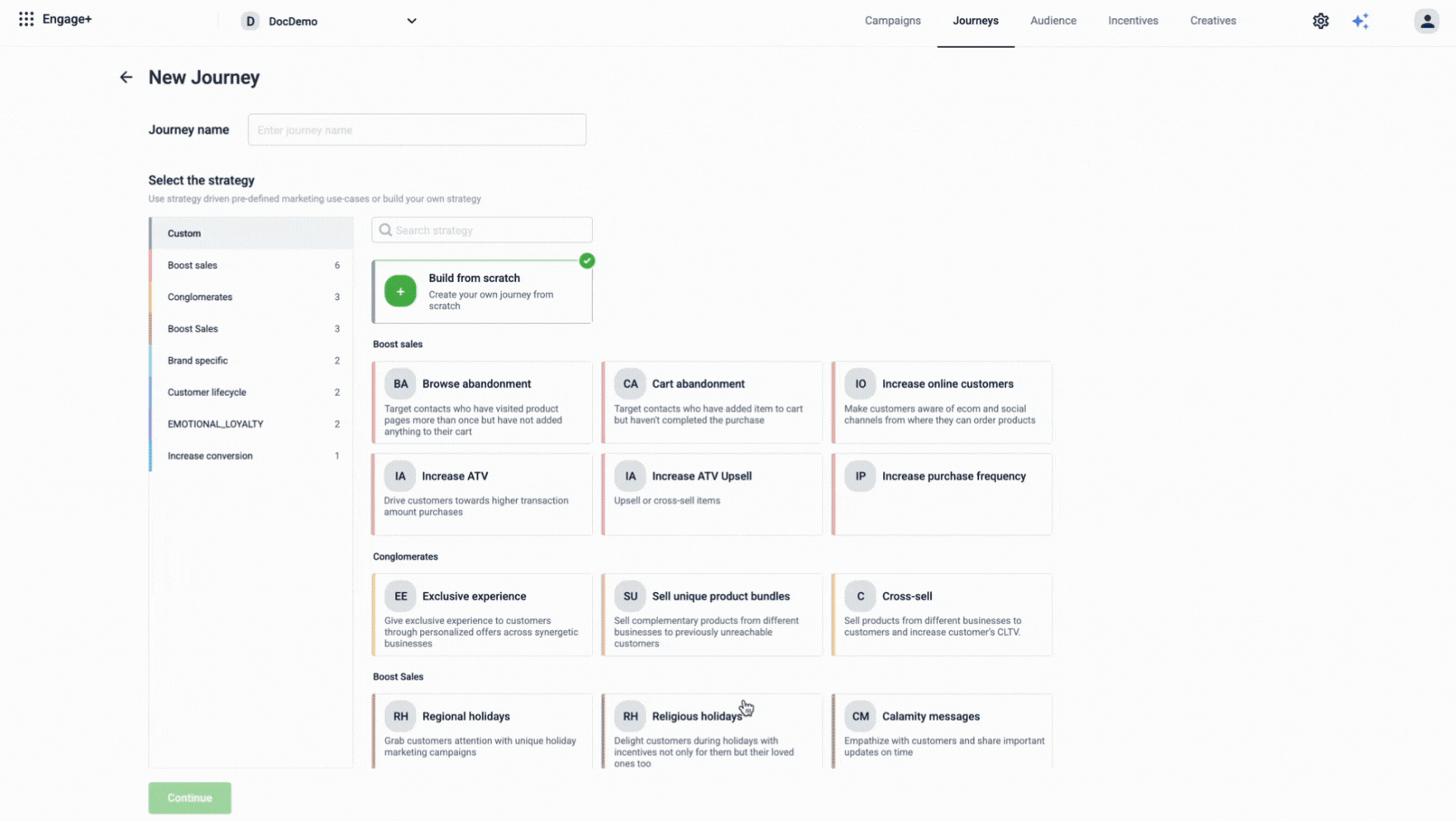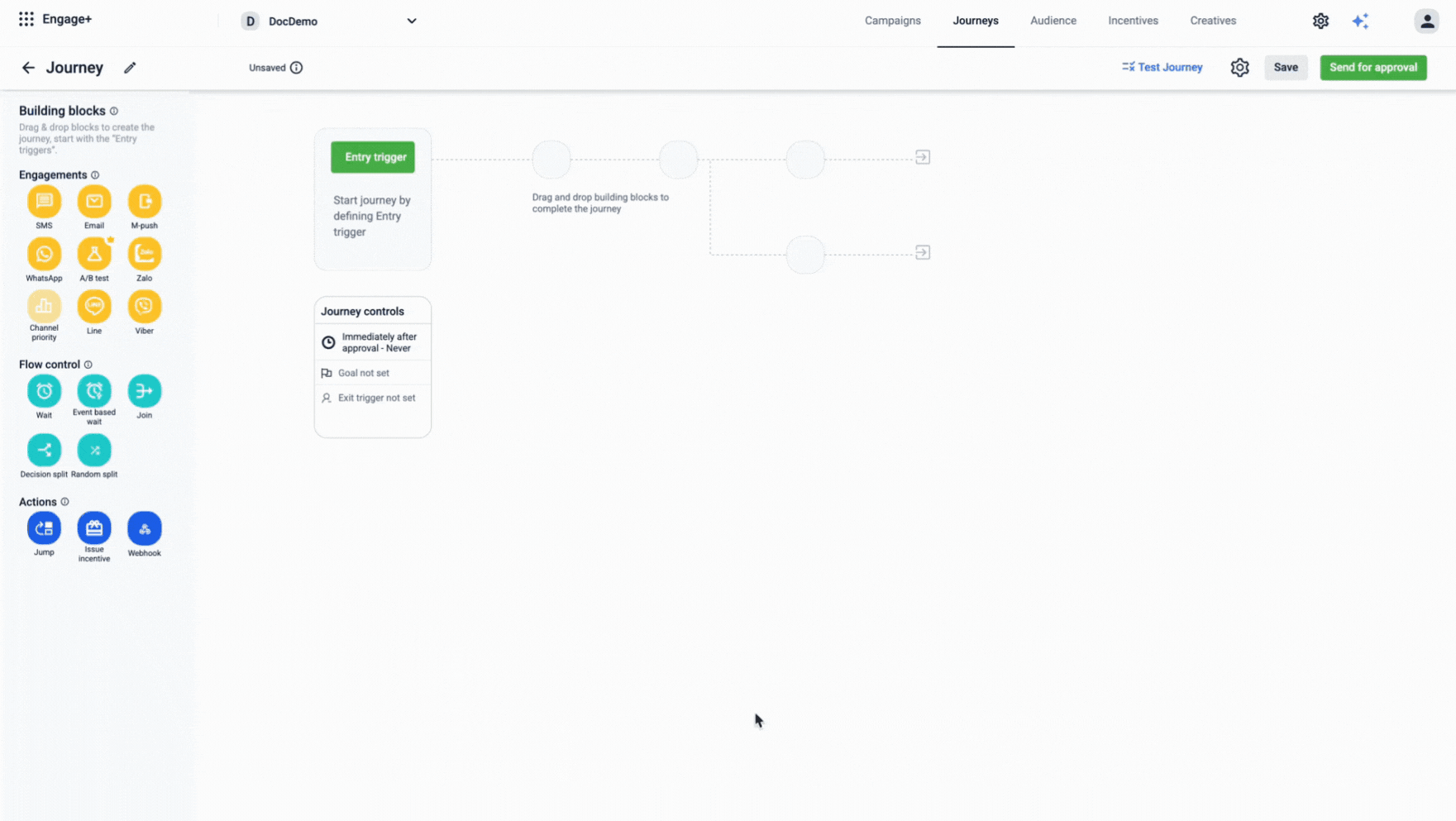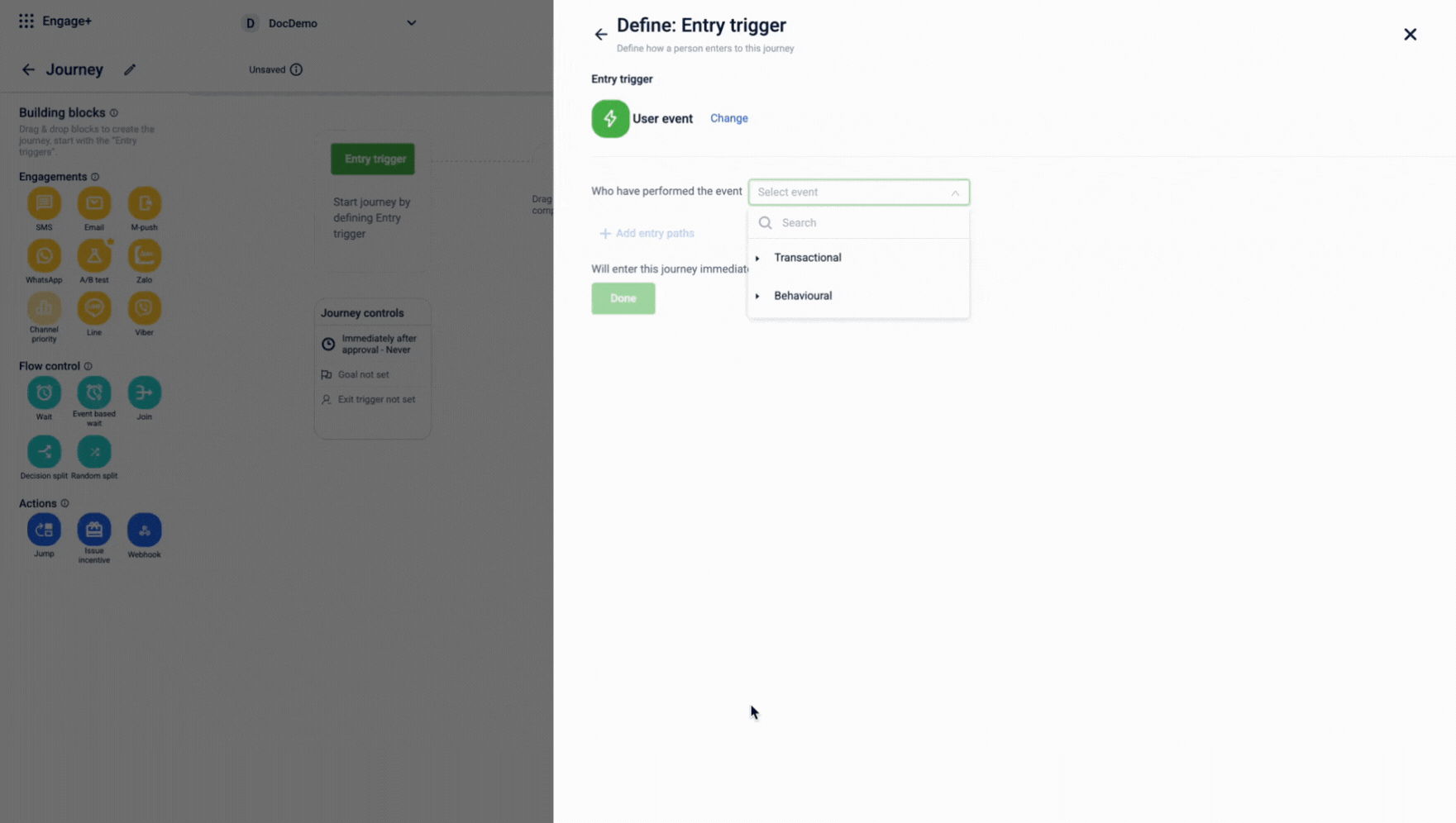Configure Events and Conditions
Events in a journey are a user event, also known as entry trigger, wherein the customer enters the journey based on any transactional or non-transactional activity (behavioral events). You can further add conditions based on the selected event to define which customers qualify to enter the journey. With the help of user events, brands can include multiple paths within a journey depending on customer activity.
There are two types of user events -
- Transactional events - This refers to customer activity related to a purchase, transaction, registration, or coupon redeemed which can be used to trigger or personalize customer journeys. When adding a transactional event, the brand must select specific events that define when customers will enter the journey.
- Behavioral events - This refers to user activities that can be tracked and used to trigger or personalize journeys. These events include both standard events and custom events.
- Standard events are predefined and based on common attributes such as price, quantity, productType, cardId, and productName.
- Custom events can be created to track specific user actions that are not covered by standard events. For steps to create custom events, refer to the Add and Map Custom Event documentation.
You can also use behavioral events to define conditions, filter your audience, and create different journey paths based on user behavior.
Notes
- Newly created Behavioral Events (BE) will appear in the Journeys dropdown one day after creation.
- When configuring a Behavioral Event, make sure to select the “Loyalty” checkbox.
Adding transactional events
To add a transactional event perform the following:
- Create a new journey.
- On the journey canvas, select Entry Trigger.
- Choose User Event as the type of entry trigger.
- From the Who have performed the event drop-down, select the event type Transactional.
- From the list of available transactional events, select the one that best matches the action you want to trigger the journey. The table below lists the available events along with their descriptions.
| Event condition | Description |
|---|---|
| Current transaction | Checks when a user enters into a journey when a transaction is completed. |
| Customer registration | Checks when a user enters into a journey based on the customer registration event. Configure the associated rules and actions as needed. |
| Coupon redeem | Checks when a user enters into a journey when a coupon is redeemed . Use this event to configure actions based on coupon redemption. |
| Target enrollment | Checks when a user enters into a journey when they are enrolled in a target . |
| Target value achieved | Checks a user enters into a journey when the predefined target value is achieved . |
| Partner program linked | Checks when a user enters into a journey when they are linked to a partner program . |
| Promotion issued | Checks when a user enters into a journey when a promotion is issued to them . |
| Customer update | Checks when a user enters into a journey based on the customer update event. |
| Reward issued | Checks when a user enters into a journey whenever a reward is issued . |
| Points issued | Checks when a user enters into a journey when points are issued . |
| Coupon issued | Checks when a user enters into a journey when a coupon is issued . |
| Tier upgraded | Checks when a user enters into a journey their tier is upgraded . |
| Tier downgraded | Checks a when user enters into a journey when their tier is downgraded . |

Adding behavioral events
To add behavioral events perform the following:
- Create a new journey.
- On the journey canvas, select Entry Trigger.
- Choose User Event as the type of entry trigger.
- From the Who have performed the event drop-down, select the event type Behavioral.
- From the list of available behavioral events, you can either select from the existing custom events (if they meet your requirements) or create your own custom events.

Adding conditions in user event
Conditions in a User Eventallow you to define which customers can enter a journey based on specific criteria. For example, if you want to send an engagement offer only to customers who haven’t made a purchase in the past month, you can set a condition to include only those customers. This ensures that your journey targets the right audience.
You can set conditions based on either Transactional Events or Behavioral Events. When you select a Transactional Event, a list of available events appears from which you can choose the specific customer action to track. Similarly, when you select a Behavioral Event, you can choose from relevant customer interaction events to define your entry conditions.
Adding conditions for transactional events
To add conditions for Transactional Events, perform the following:
- Create a new journey.
- On the journey canvas, selectEntry Trigger.
- Choose User Eventas the type of entry trigger.
- From the Who have performed the event drop-down, select the event type Transaction event.
- Select +Add entry paths to define further criteria for the customer to enter the journey.
- Select +Conditions to add further conditions. For transactional event types, you can define conditions using various attributes based on the selected transactional type. These attributes help segment and direct customers through different paths based on specific characteristics or purchase details, such as loyalty status or engagement patterns.

Event Profiles and Attribute
The table below lists the available attributes for all transactional and behavioral event types along with their descriptions.
Transactional event
- Customer profile ( This applies to all the transaction event type )
| Attributes | Description |
|---|---|
| Customer's segments | Check if the customer belongs to a specific segment or cluster (such as a behavioral or demographic group). |
| Lifetime points | Check if the customer’s total accumulated loyalty points (lifetime points) meet a specified threshold. |
| Lifetime transaction amount | Check if the customer’s total spend (lifetime purchase value) reaches a defined amount. |
| Customer extended fields filter | Check if a customer’s profile contains a specific value in an extended field. |
| Linked supplementary program | Check if the customer is linked to a specific supplementary or partner program. |
| External ID | Check if the customer’s profile matches a specific external ID or pattern. |
| Customer custom fields filter | Check if a customer’s profile contains (or does not contain) a specific value in a custom field. |
| Current points balance | Check if the customer’s current balance of redeemable points meets a specified condition. |
- Transaction profile (This applies to Current transaction event type)
Attributes | Description |
|---|---|
Transaction date | Check if a transaction occurs on a specific date or within a date range. |
Transaction value | Check if the total value of a transaction meets a specified condition. |
Extended fields in the transaction | Check if a transaction contains a specific value in an extended field. |
Total discount | Check if the total discount applied to a transaction meets a specified condition. |
Transaction number | Check if the transaction number (or ID) matches a specific value or pattern. |
Line-item count | Check if the number of line items in a transaction meets a specified condition. |
Basket amount | Check if the total value (amount) of a transaction's basket meets a specified threshold. |
Bill points | Check if the number of points awarded for a transaction meets a specified condition. |
Transaction Id | Check if a transaction matches a specific transaction ID. |
Custom fields in the transaction | Check if a transaction contains a specific value in a custom field. |
Gross amount | Check if the gross amount (total before discounts) of a transaction or its line items meets a specified condition. |
Bill date | Check if the transaction occurred on a specific bill date or within a date range. |
Outlier stauts | Checks whether the transaction is normal or flagged with a specific status such as FRAUD, or RETRO. |
- Store profile (This applies to Current transaction, customer update , coupon issued and coupon redeem event type)
| Attributes | Description |
|---|---|
| Zone | Check if a transaction occurs in a specific geographical zone or region. |
| Concept | Check if a transaction occurs in a specific concept (a logical grouping of stores, like a brand). |
| Concept name | Check if a transaction occurs in a store belonging to a specific concept name. |
| Store | Check if a transaction occurs at a specific store. |
- Customer Registration Event Profile (This applies to Customer registration event type)
| Attributes | Description |
|---|---|
| Customer Registration Event Source | Channel through which the registration happened. |
| Created At | Timestamp when the registration event was created. |
| Entered At | Timestamp when the customer was added to the system. |
- Cart promotion / Gift voucher redemption (This applies to Cart promotion / Gift voucher event type which is triggered when a user performs the entry action)
| Attributes | Description |
|---|---|
| Cart promotion / Gift voucher redeemed from mentioned promotions | Check if the user has redeemed a cart promotion or gift voucher from the specified promotions. |
| Created At | The date when the redemption event was captured. |
- Target Profile (This applies to Target enrollment, Target value achieved and Promotion issued event type)
| Attributes | Description |
|---|---|
| Target Rule ID | Unique identifier of the target rule. |
| Target Rule Name | Name of the target rule. |
| Target Group Start Date | Start date of the associated target group. |
| Target Group End Date | End date of the associated target group. |
| Target Group ID | Unique identifier of the target group. |
| Target Group Name | Name of the target group. |
- Partner Program Profile (This applies to Partner program linked event type)
| Attribute | Description |
|---|---|
| Linked Supplementary Program | Name of the linked supplementary partner program. |
- Promotion Profile (This applies to Promotion issued event type)
| Attributes | Description |
|---|---|
| Promotion Name | Name of the issued promotion. |
| Promotion Start Date | Start date of the promotion. |
| Promotion End Date | End date of the promotion. |
| Promotion Issued Date | Date when the promotion was issued. |
| Promotion Issued Expiry Date | Expiry date of the issued promotion. |
- Customer Updated Profile (This applies to Customer update event type)
| Attribute | Description |
|---|---|
| Customer Previous Custom Fields Filter | Previous custom field values. |
| Customer Previous Label | Previously assigned customer label. |
| Customer Current Label | Current assigned customer label. |
| Customer Current Custom Fields Filter | Current custom field values. |
| Customer Previous Extended Fields Filter | Previous extended field values. |
| Customer Current Extended Fields Filter | Current extended field values. |
| Customer Previous Status | Customer’s previous status. |
| Customer Current Status | Customer’s current status. |
| Customer Updated Event Source | Source of the update event. |
| Created At | Timestamp when the update was captured. |
- Reward Issued Profile (This applies to Reward issued event type)
| Attribute | Description |
|---|---|
| Reward Group | Category or group of the reward. |
| Reward Redemption Type | Redemption method (e.g., online/offline). |
| Reward Label | Label assigned to the reward. |
| Reward Type | Type of reward issued. |
- Points issued Profile (This applies to Points issued event type)
| Attribute | Description |
|---|---|
| Triggering Activity Name | Activity that triggered the point issuance. |
| Total Points Issued | Total points granted to the customer. |
| Created At | Timestamp when points were issued. |
- Coupon Series Profile (This applies to Coupon issued and coupon redeem event type)
| Attributes | Description |
|---|---|
| Coupon Series Type | Type/category of the coupon series. |
| Added At Date | Date when the series was added. |
| Coupon from Mentioned Series | Specific coupon issued to the customer. |
| Coupon Series Description | Description of the coupon series. |
| Created At Date | Timestamp when the coupon was issued. |
- Coupon Redeem Profile ( This applies to Coupon reedem event type which is triggered when a user performs the entry action. )
| Attribute | Description |
|---|---|
| Coupon Code | The unique code of the coupon triggered the redemption event. |
| Coupon Redemption Date | The date when the coupon was redeemed. |
| Coupon Series Id | Identifier of the coupon series to which the redeemed coupon belongs. |
| Coupon Id | Unique identifier of the redeemed coupon. |
- Tier Upgraded Profile (This applies to Tier upgraded event type)
| Attribute | Description |
|---|---|
| Created At | Timestamp when the tier upgrade was processed. |
| Loyalty Program ID | Identifier of the loyalty program. |
| Previous Tier Number | Customer’s previous tier. |
| Tier Upgraded Expiry Date | Expiry date of the upgraded tier. |
| Tier Upgraded Number | New tier assigned to the customer. |
- Tier downgraded Profile (This applies to Tier downgraded event type)
| Attribute | Description |
|---|---|
| Created At | Timestamp when the tier downgrade happened. |
| Loyalty Program ID | Identifier of the loyalty program. |
| Tier Downgraded Number | New downgraded tier assigned. |
| Previous Tier Number | Customer’s previous higher tier. |
| Tier Downgraded Expiry Date | Expiry date of the downgraded tier. |
Behavioral event
For behavioral event type you can define conditions using three key attributes. The available attribute categories are Customer Profile, Store Profile and Behavioral Event Profile. The Customer Profile and Store Profile attributes are the same as those used for transactional events. However, for the Behavioral Event Profile, you need to configure the attributes based on your specific requirements.
Updated 5 days ago
